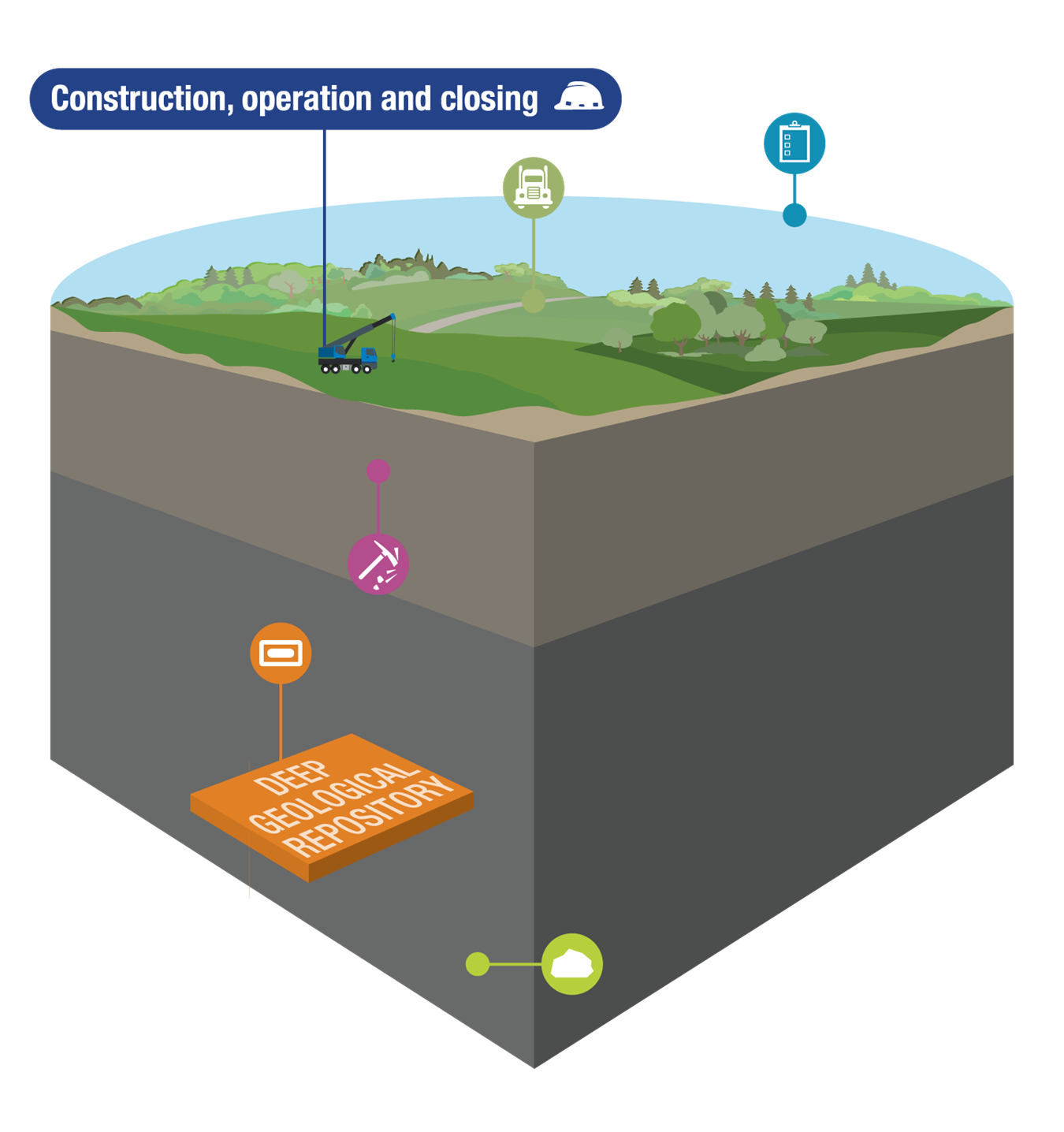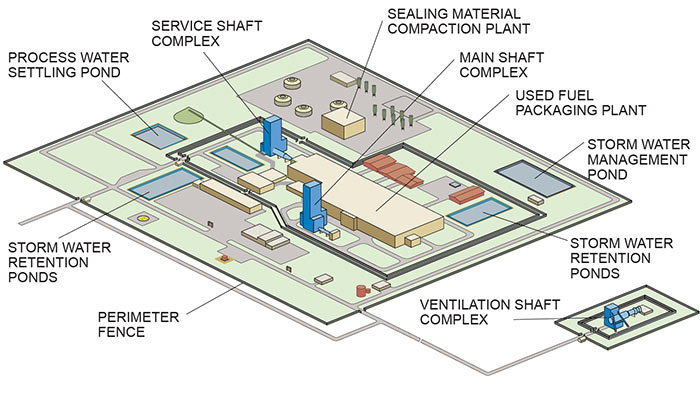Canada's deep geological repository for used nuclear fuel
Canada’s plan to construct a deep geological repository for the safe, long-term management of used nuclear fuel is consistent with international best practices. This approach is the culmination of more than 30 years of research, development and demonstration of technologies and techniques.
Overview
Canada's deep geological repository for used nuclear fuel will use a multiple-barrier system designed to safely contain and isolate used nuclear fuel over the very long term. Built to a depth of 650-800 metres below ground, the repository will consist of a network of placement rooms that will store the used nuclear fuel.
Wabigoon Lake Ojibway Nation and the Township of Ignace will be the host communities for the future site for Canada’s deep geological repository for used nuclear fuel. Learn more about the area.
Rigorous safety standards govern the project. We have committed to meet or exceed all applicable federal and provincial regulatory requirements to protect the health, safety and security of people and the environment for generations to come.
#DidYouKnow: What is a deep geological repository?
Watch now
A conceptual layout for a deep geological repository
The deep geological repository is designed to safely contain and isolate Canada's used nuclear fuel over the long term, including that generated by new or emerging technologies. It will include a network of underground tunnels and placement rooms for used nuclear fuel containers.

A conceptual layout for a repository would require an underground footprint of about two kilometres by three kilometres (about 600 hectares or 1,500 acres). The depth of the repository would be such that future inadvertent human intrusion into the closed repository would be very unlikely.
At the surface, there will be facilities where the used fuel is received, inspected and repackaged into purpose-built containers encased in a bentonite clay buffer box, before being transferred to the main shaft for underground placement. There will also be facilities for administration, security, processing of sealing materials, quality control and ongoing operation and monitoring of the site.
The repository will include a centralized services area that will allow for underground ventilation through three shafts located within a single, secure area. The layout also includes multiple access tunnel arms that will let our technical specialists situate the placement rooms in areas with the most suitable rock. The buffer boxes will be arranged in the horizontal placement rooms, and any spaces left over will be backfilled with bentonite clay pellets or chips.
The actual underground footprint at any particular site would depend on a number of factors, including the characteristics of the rock, the location of underground features in the rock, the final design of the repository and the total inventory of used fuel to be managed.
The rock at the site is crystalline rock. To construct the deep geological repository, rock excavation will primarily be done using a method that involves controlled drilling and blasting. Rock boring technology may also be used depending on the final design and site conditions.
To prepare for the regulatory decision-making process and construction, the NWMO has begun work on conceptual designs of the repository layout based on geoscience assessments and initial borehole drilling at the site. This is an iterative process which will involve additional site characterization activities.

Multiple-barrier system

Confidence in safety
In 2022 we published a Confidence in Safety report for the Wabigoon Lake Ojibway Nation and Township of Ignace area, which was updated in 2024.
The report is based on years of research and fieldwork and summarizes the NWMO’s understanding of the siting area, including geological characteristics that indicate it can meet the project’s requirements to contain and isolate used nuclear fuel to protect people and the environment.
Additional studies will be undertaken to further inform the repository design and long-term safety case.
Monitoring
There will be an extensive environmental and operational monitoring program for ground and surface water, radiation, air quality, fire and more. This monitoring will start prior to construction and will continue through operations. There will also be an extended monitoring period following placement of the used nuclear fuel to ensure the repository is performing as expected.
Deep geological repository
View all FAQsHow will people and the environment be protected?
Canada's plan for the safe, long-term management of used nuclear fuel involves containing and isolating it in a deep geological repository.
The safety of people and the environment is the top priority in the process for selecting a repository site. We will need to demonstrate that any site selected can safely contain and isolate used nuclear fuel for a very long period of time. There cannot be any credible risk from the repository to the public or the environment.
The repository will be located deep underground in a suitable rock formation, which must meet site selection technical criteria for the development of a robust safety case. This approach is consistent with international best practices, and is the culmination of more than 30 years of research, development and demonstration of technologies and techniques.
The repository uses multiple barriers that include the waste form, container, sealing materials and host rock. The system is designed such that the unlikely failure of one component would not jeopardize the safety of the containment system as a whole.
The project will also be subject to a thorough regulatory review process, including an environmental assessment and a licensing review, to ensure that it is implemented in a manner that protects people and the environment.
Once placed in the repository, the used nuclear fuel will be monitored for an extended period of time.
What facilities will be constructed?
Canada's plan for the long-term management of used nuclear fuel involves its containment and isolation at a repository site. Facilities associated with the project will include:
- A Centre of Expertise that will support the multi-year testing of the site. It will include public viewing galleries to showcase both the technology and science, and the engagement efforts that have gone into the implementation of Canada's plan;
- A deep geological repository to contain and isolate Canada's used fuel over the long term; and
- Surface facilities, including security, quality control laboratories, sealing materials production plants and all the other functions required to support the safe receipt and storage of used fuel bundles. These facilities will also support the repackaging and transfer of used fuel bundles to the underground repository.
Where will the repository be located?
On Nov. 28, 2024, the Nuclear Waste Management Organization selected Wabigoon Lake Ojibway Nation and the Township of Ignace as the host communities for Canada’s deep geological repository for used nuclear fuel.
Canada's long-term plan for used nuclear fuel requires that the deep geological repository be located in an area with informed and willing hosts, at a site that meets rigorous technical and safety criteria.
In 2010, the NWMO began a multi-year site selection process to identify a suitable location for the deep geological repository. The process was designed to ensure the site selected is safe and secure, meeting or exceeding all regulatory requirements. Only areas where at least one community expressed interest in learning about the project and exploring their potential to host it were considered.
How long will you monitor the used nuclear fuel?
The transportation, handling and placement of the used nuclear fuel in the deep geological repository is expected to take place over a period of 45 to 50 years — into the 2080s. The repository will be monitored throughout all these activities.
There will also be an extended period of monitoring, which could last several decades (70 years has been assumed for financial planning purposes). Many decades from now, in collaboration with regulatory authorities, the community will decide the form and duration of this monitoring.
Following the period of extended monitoring, the decommissioning and closure of the facility is expected to take about 30 years. Details for the monitoring following closure will be decided in collaboration with future society.

